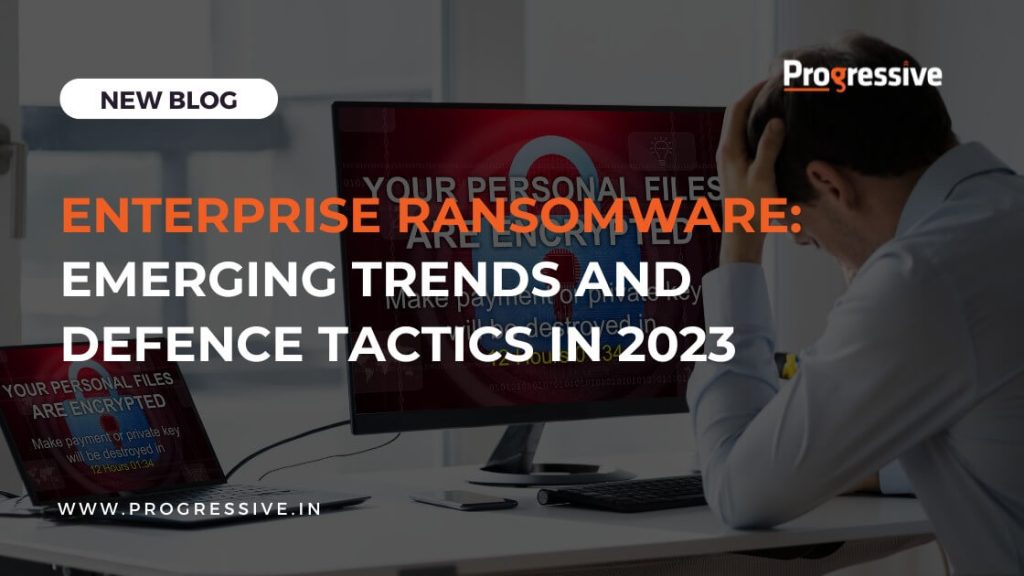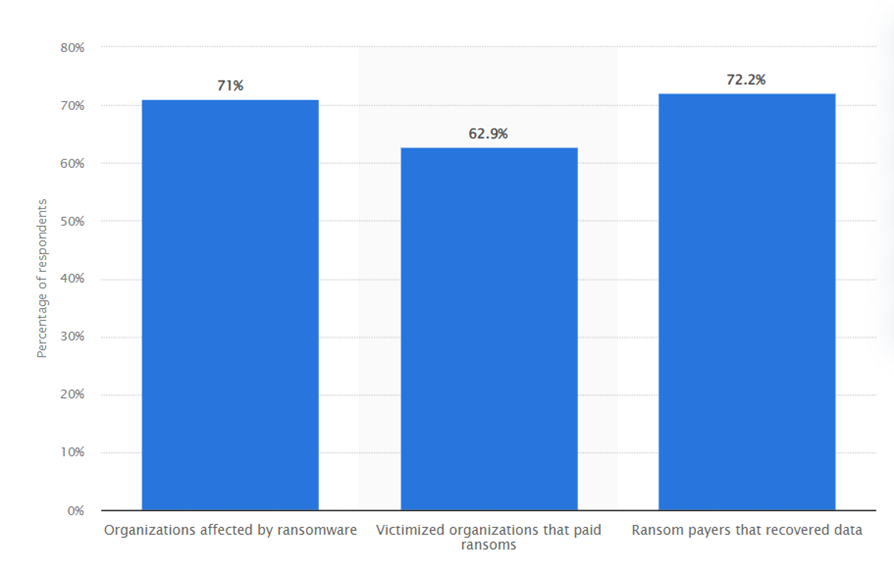
Enterprises face imminent danger as ransomware attacks are becoming increasingly sophisticated and prevalent. Implementing robust cybersecurity measures is crucial to safeguard sensitive data, intellectual property, and operational continuity. By prioritizing enterprise ransomware protection, leaders can avoid financial losses, reputational damage, legal repercussions, and potential disruption of critical services.
Know what’s happening –
- Every day, there are 1.7 million ransomware attacks, averaging 19 attacks per second. – Economic Times
- In 2022, on average, a ransomware attack cost around $1.85 million. – IBM
- Approximately one-fourth of all data breaches in 2022 were attributed to ransomware attacks. – Verizon
- 35% of companies had to face C-level resignations due to a ransomware attack. – CXO Today
Emerging 2023 Trends in Ransomware Attacks
According to Cybersecurity Ventures, Ransomware attacks are increasing in frequency and sophistication, with damage costs projected to reach $265 billion annually by 2031.
- In 2022, there was a 10% rise in attacks and a 17% increase in average ransom demand, a trend expected to persist in 2023.
- Cloud-based systems are increasingly targeted by ransomware attacks, reflecting the growing reliance on cloud computing by businesses.
- Double extortion tactics, involving data theft and publication threats, are becoming more common as ransomware attackers seek to pressure victims into paying.
The escalating frequency and sophistication of enterprise ransomware attacks are alarming. As businesses increasingly rely on cloud-based systems, the need for robust security measures becomes imperative. The rising prevalence of double extortion tactics adds to the urgency of implementing ransomware defence strategies to protect valuable assets.
Understanding Enterprise Ransomware
What is Enterprise Ransomware?
Enterprise ransomware is a sophisticated form of malware specifically designed to infiltrate advanced computer systems and encrypt essential files and databases of large businesses. It specifically targets large organizations, aiming to extract higher ransoms due to the potential impact on their operations and reputation.
Once infected, the cybercriminals behind the attack demand a ransom, usually in cryptocurrency, in exchange for the decryption key. This type of ransomware poses a significant threat to large organizations, as the consequences can be financially devastating and reputationally damaging.
The Devastating Impact of Enterprise Ransomware
According to Statista, a staggering 71% of companies were impacted due to ransomware across the globe. As ransomware attacks continue, organizations need to bolster their cybersecurity defences and implement robust preventive measures to safeguard their business operations.

The research further reveals that –
- Large enterprises are more likely to be targeted by ransomware attacks than small businesses. In 2022, 76% of large enterprises were attacked by ransomware, compared to 57% of small businesses.
- The average ransom demand for large enterprises is higher than for small businesses. In 2022, the average ransom demand for large enterprises was $268,000, compared to $178,000 for small businesses.
- Large enterprises are more likely to pay the ransom than small businesses. In 2022, 31% of large enterprises paid the ransom, compared to 19% of small businesses.
- The average cost of a ransomware attack for large enterprises is higher than for small businesses. In 2022, the average cost of a ransomware attack for large enterprises was $2.2 million, compared to $1.5 million for small businesses.
Enterprises can face severe consequences from ransomware attacks. These attacks not only lead to monetary losses, but the expenses incurred for recovery, downtime, and damage to your reputation can be 10 to 15 times higher than the ransom itself.
Proactive Measures to Prevent Enterprise Ransomware
Web Filtering and Email Security
Implement a comprehensive web filtering solution that blocks access to malicious websites and filters out suspicious email attachments and links to prevent ransomware infections through web browsing and email communication.
Endpoint Protection
Deploy endpoint protection software on all devices, including desktops, laptops, and servers, to detect and prevent ransomware attacks. This software should include real-time scanning, behaviour monitoring, and heuristic analysis to identify and mitigate threats.
Employee Education
Conduct regular training sessions to educate employees about the risks and best practices associated with ransomware. Teach them how to recognize suspicious emails, phishing attempts, and potentially harmful websites. Encourage them to report any suspicious activities promptly.
Strong Password Policies
Enforce strong password policies that require employees to use complex passwords with a minimum length, a combination of alphanumeric characters, and regular password updates. Implement password management tools to help employees create and securely store their passwords.
Multi-Factor Authentication
Enable multi-factor authentication (MFA) across all systems and applications to add an extra layer of security. MFA requires users to provide additional verification, such as a one-time password or biometric authentication, along with their regular login credentials.
Regular Software Updates
Regularly update all software and applications, including operating systems and third-party programs, to patch vulnerabilities that ransomware can exploit. Implement an automated patch management system to ensure timely updates across the enterprise.
Robust Backup and Recovery
Establish a robust backup and recovery strategy that includes frequent backups of critical data stored both onsite and offsite. Test the backups regularly to ensure they are reliable and accessible in the event of a ransomware incident.
Network Segmentation
Implement network segmentation to isolate critical systems and limit lateral movement in case of a ransomware infection. Restrict access between different network segments and ensure that sensitive data and critical systems have an additional layer of protection.
24×7 SOC Monitoring
Establish a Security Operations Center (SOC) or partner with a managed security service provider to monitor the network and systems 24×7. SOC analysts should actively monitor for potential ransomware threats, respond to alerts, and investigate any suspicious activities.
Ransomware Incident Response Plan
Develop a comprehensive ransomware incident response plan tailored according to your systems. This plan should outline the steps to be taken in case of a ransomware incident, including the isolation of infected systems, communication protocols, and recovery procedures.
Regular Security Audits
Conduct cybersecurity audits to assess the effectiveness of security controls and identify any vulnerabilities or weaknesses. These audits should include penetration testing, vulnerability scanning, and a review of security policies and procedures to ensure compliance and continuous improvement.
The Future of Ransomware: Predictions and Projections
- Ransomware threats are expected to cause more than $30 billion in damages by the end of 2023, making them the costliest among all cyber breaches. – TechWireAsia
- The world will have to protect 338 billion lines of new software code by 2025, based on a 15% year-over-year growth in new code. – Cybercrime Magazine
- By 2025, approximately 30% of countries will establish legislation that regulates ransomware payments, penalties, and negotiations, a significant increase from the less than 1% recorded in 2021. – Gartner
Considering these future trends, choosing a managed security services provider becomes a strong step towards safeguarding your organization against ransomware threats. Businesses can ensure comprehensive protection, stay ahead of evolving threats, and minimize the impact of enterprise ransomware breaches.
Level Up Your Ransomware Defence System with Progressive
Stay vigilant, stay informed, and protect your business from enterprise ransomware with Progressive Infotech. We provide next-generation ransomware protection leveraging our 24×7 Security Operations Center based on a multi-layered system that combines anti-malware, SIEM, SOAR, vulnerability assessment, patch management, UEBA, and backup capabilities to ensure 360° enterprise ransomware prevention and security.
Get Started with Proactive Enterprise Ransomware Protection. Book a Call Now!